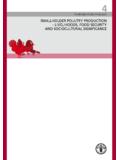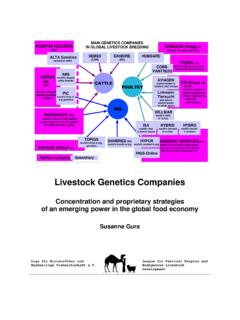Transcription of A review of the current poultry disease control strategies ...
1 A review of the current poultry diseasecontrol strategies in smallholderpoultry production systems andlocal poultry populations in UgandaAHBL Promoting strategies for prevention and control of HPAIA review of the current poultry diseasecontrol strategies in smallholderpoultry production systems andlocal poultry populations in UgandaTerence Odoch Amoki and Clovice KankyaDepartment Veterinary Public Health and Preventive MedicineFaculty of Veterinary Medicine, Makerere UniversityEunice L KyomugishaPrivate Consultant, KampalaDenis K. ByarugabaConsultantFood and Agriculture Organization ofthe United Nations (FAO), KampalaNicoline de Haan andKarin SchwabenbauerFood and Agriculture Organization ofthe United Nations (FAO), RomeFOOD AND AGRICULTURE ORGANIZATION OF THE UNITED NATIONSRome, January 2009 The designations employed and the presentation of material in this information product do not imply the expression of any opinion whatsoever on the part of the Food and Agriculture Organization of the United Nations (FAO) concerning the legal or development status of any country, territory, city or area or of its authorities, or concerning the delimitation of its frontiers or boundaries.
2 The mention of specific companies or products of manufacturers, whether or not these have been patented, does not imply that these have been endorsed or recommended by FAO in preference to others of a similar nature that are not rights reserved. Reproduction and dissemination of material in this information productfor educational or other non-commercial purposes are authorized without any priorwritten permission from the copyright holders provided the source is fully acknowledged. Reproduction of material in this information product for resale or other commercial purposes is prohibited without written permission of the copyright for such permission should be addressed to:ChiefElectronic Publishing Policy and Support BranchCommunication DivisionFAOV iale delle Terme di Caracalla, 00153 Rome, Italyor by e-mail FAO 2009 AUTHORS DETAILST erence Odoch Amoki and Clovice KankyaDepartment Veterinary Public Health and Preventive Medicine Faculty of Veterinary Medicine, Makerere UniversityEunice L KyomugishaPrivate Consultant, KampalaDenis K.
3 ByarugabaConsultantFood and Agriculture Organization of the United Nations (FAO), KampalaNicoline de Haan and Karin SchwabenbauerConsultantsFood and Agriculture Organization of the United Nations (FAO), CITATIONFAO. 2009. A review of the current poultry disease control strategies in smallholder poultry production systems and local poultry populations in uganda . Prepared by Terence Odoch Amoki, Clovice Kankya, Eunice L Kyomugisha, Denis K. Byarugaba, Nicoline de Haan and Karin Schwabenbauer. AHBL - Promoting strategies for prevention and control of HPAI. Rome. 1 A review of the current poultry disease control strategies in smallholder poultry production systems and local poultry populations in uganda Animal Health, Breeds and Livelihoods Contents FIGURES/ TABLES.
4 2 PHOTOS .. 2 ACRONYMS .. 3 SUMMARY .. 4 7 BACKGROUND TO THE STUDY ..8 SCOPE OF THE 9 STUDY ARUA 10 LIRA 10 KANUNGU 10 JINJA 10 TORORO 11 SAMPLING OF 11 DATA 11 QUANTITATIVE 11 QUALITATIVE 11 FOCUS GROUP 12 KEY INFORMANT 12 DATA 12 RESULTS AND DISCUSSION .. 13 poultry PRODUCERS AND production SYSTEMS .. 13 poultry MANAGEMENT IN THE 13 IMPORTANCE OF LIVESTOCK production IN THE STUDY 15 CHANGING DEMAND FOR LIVESTOCK 15 THE ROLE OF VACCINATION IN CONTROLLING poultry 15 PARTICIPANTS EXPERIENCE OF VACCINATION 18 KEY INFORMANTS EXPERIENCES OF VETERINARY AND VACCINATION 19 CONSTRAINTS TO 20 LESSONS 20 disease control strategies .. 22 EFFECTIVE AND SUSTAINABLE disease control strategies FOR CHANGING DEMANDS IN THE poultry 23 DISTRICT-LEVEL poultry production IMPROVEMENT 24 DISTRICT-LEVEL PROGRAMMES FOR THE IMPROVEMENT OF poultry HEALTH 25 PERSONNEL FOR poultry production AND HEALTH 26 BUDGETARY ALLOCATIONS AND CONSTRAINTS FOR THE poultry 27 CREDIT SERVICES AVAILABLE TO smallholder poultry production 28 EFFECTIVENESS AND SUSTAINABILITY OF current strategies FOR disease 28 disease RISK MANAGEMENT.
5 29 poultry disease RISK 29 SHARING OF poultry 29 DIFFERENT poultry SPECIES HATCHED AND KEPT 30 MARKETING 30 IMPLICATIONS OF FINDINGS FOR disease RISK 35 CONCLUSIONS AND 35 35 2 A review of the current poultry disease control strategies in smallholder poultry production systems and local poultry populations in uganda Animal Health, Breeds and Livelihoods 36 HOUSEHOLD-/COMMUNITY-BASED 37 DISTRICT-/INSTITUTIONAL-BASED 37 39 ANNEXES .. 40 ANNEX 1 TERMS OF 40 ANNEX 2 QUANTITATIVE INSTRUMENT HOUSEHOLD 41 ANNEX 4 SUB-COUNTIES, PARISHES AND VILLAGES COVERED DURING 52 ANNEX 5 KEY INFORMANTS INTERVIEWED PER 53 ANNEX 7 production SECTOR, JINJA: VETERINARY DEPARTMENT WORK PLAN AND BUDGET: 2007/2008 55 Figures/ Tables Figure 1 The study Figure 2 Vaccinations in the five study districts.
6 17 Figure 3 Disposal of dead poultry across the districts ..32 Figure 4 Methods for disposing of dead Table 1 Characteristics of households and respondents ..13 Table 2 Types of housing for poultry ..14 Table 3 Vaccinations of Table 4 Accessibility and reliability of vaccines ..18 Table 5 poultry disease occurrence in households ..22 Table 6 Gaps in poultry health service delivery mentioned by smallholder Table 7 Participants perceived challenges to achieving a sustainable disease control ..24 Table 8 Sources of information on poultry production and health ..26 Table 9 Access to and provision of extension services ..26 Table 10 Chickens sharing of housing ..29 Table 11 Participants perceptions of disease risk factors ..34 Photos Photo 1 Women poultry farmers discussing gender issues in poultry keeping, Lira Photo 2 A beneficiary of the Saturday vaccinations feeding his poultry , Tororo Photo 3 poultry farmers who do not belong to a farmers group and have not benefited from NAADS, Arua district.
7 19 Photo 4 A participant showing some of the herbs used to treat poultry , Arua district ..23 Photo 5 poultry in a market owned by a poultry vendors association, where weekly disinfection is carried out, Lira Photo 6 Participants laugh about eating chickens that have been bitten by a snake, Tororo district ..33 3 A review of the current poultry disease control strategies in smallholder poultry production systems and local poultry populations in uganda Animal Health, Breeds and Livelihoods Acronyms AHBL Animal Health Breed and Livelihood CAO Chief Administrative Officer CBO community-based organization CBR Community-Based Rehabilitation CHOGM Commonwealth Heads of Government Meeting DRC Democratic Republic of the Congo DVO district veterinary officer FGD focus group discussion FAO Food and Agriculture Organization of the United Nations GDP gross domestic product HPAI highly pathogenic avian influenza KII key informant interview LGDP Local Government Development Programme MAAIF Ministry of Agriculture.
8 Animal Industry and Fisheries NAADS National Agricultural Advisory Services NCD Newcastle disease NGO non-governmental organization PAF Poverty Alleviation Fund PMA Plan for Modernization of Agriculture PRA participatory rural appraisal 4 A review of the current poultry disease control strategies in smallholder poultry production systems and local poultry populations in uganda Animal Health, Breeds and Livelihoods Summary This study was conducted to review the poultry disease control strategies currently used in smallholder poultry production systems and local poultry populations in uganda . The study has three main objectives: to gain a better understanding of the role that vaccination can play in controlling highly pathogenic avian influenza (HPAI); to identify effective and sustainable strategies for disease control that can deal with changing demands for animal health services and service delivery; to identify key areas for change in disease risk management and improved production , and practical ways of achieving these.
9 Five districts, each in a different region of uganda , were selected for the study: Tororo in the east, Jinja in the southeast, Lira in the north, Arua in the northwest and Kanungu in the southwest. The main selection criterion was large numbers of poultry kept at the household level. Quantitative and qualitative data collection methods were used, and respondents/participants were men and women poultry farmers. Quantitative data were captured from a household questionnaire and key informant interviews, while qualitative methods included focus group discussions using participatory rural appraisal techniques, and key informant interviews. Participatory rural appraisal techniques included community systems analysis, a solution matrix, gender analysis, poultry disease risk factor analysis, a poultry marketing and disease risk factor matrix, ranking of the relative burdens of diseases, and discussions.
10 Various methods were used to collect data on households socio-demographic characteristics, poultry species, flock sizes, flock compositions, types of housing, types of feeding, sources of feed, provision of water, management systems, sharing of housing with other species, main sources of labour, and sources of poultry . Other data were collected on the poultry disease prevention measures used, mortality rates, vaccinations, constraints to vaccination, general poultry disease management and strategies for sustainable disease control , and extension service delivery. Results from this study show that there are low literacy levels among smallholder poultry producers. The majority of respondents were educated only to primary levels ( percent), and the proportion with no education at all ranged from percent in Jinja to percent in Tororo.













